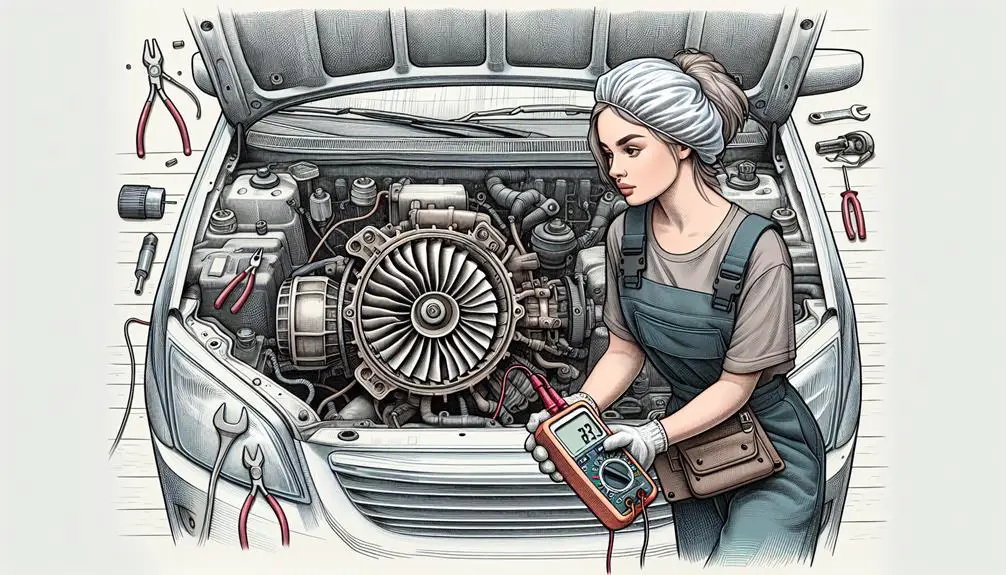Diagnosing a Bad Blower Motor involves recognizing symptoms like:
- Unusual noises
- Weak airflow
- No air from vents
Checking the fuse and inspecting the blower motor are key steps, as is understanding electrical connections. This process requires insight to effectively identify and resolve the issue.
Recognizing the Symptoms

If your car's air conditioning or heating performance has dropped, it might be a sign that your blower motor is failing. This critical component is responsible for circulating air throughout your vehicle's cabin, and when it starts to go bad, you'll definitely notice. But how can you be sure it's the blower motor and not something else? Let's delve into the symptoms you should keep an eye out for.
To start, you might hear unusual noises coming from the dashboard or where the blower motor is housed. These sounds can range from rattling to banging or even whistling when you turn the air conditioning or heating on. It's the blower motor struggling to operate properly, and it's a clear indicator something's not right.
Another telltale sign is weak airflow even at the highest setting. If you crank up the fan and barely feel a breeze, your blower motor could be the culprit. This issue not only makes your drive uncomfortable but also indicates your motor might be on its last legs.
Moreover, if the air stops flowing altogether, that's a significant sign your blower motor has failed. You might notice that no matter how you adjust the settings, the air simply doesn't circulate.
Recognizing these symptoms early on can save you from a complete blower motor failure, ensuring you're not left without heating or air conditioning when you need it most. Keep an ear out for strange sounds and an eye on the airflow, and you'll be better prepared to address any issues before they escalate.
Checking the Fuse
Before investigating the blower motor itself, it's wise to check the fuse, as a blown one can lead to the issues you're experiencing.
Ensure off, you'll need to locate the fuse box. It's usually found under the dashboard on the driver's side, though some vehicles might've it under the hood. Your owner's manual can point you in the right direction if you're unsure. Once you've found the fuse box, look for the diagram on its cover or consult your manual again to find out which fuse is for the blower motor.
Now, it's time to check the fuse. Pull it out using a fuse puller or a pair of needle-nose pliers if you don't have one. Hold the fuse up to the light and inspect the wire inside. If it's broken or the fuse appears blackened, it's blown and needs to be replaced. Make sure you replace it with a fuse of the same amperage to avoid any electrical issues.
If the fuse looks good, don't just shove it back in and call it a day. Consider giving it a clean wipe to ensure there's a good contact when you put it back. Sometimes, corrosion or dirt can cause a good fuse to lose connection, mimicking the symptoms of a blown fuse.
Checking the fuse is a quick and easy step that can save you a considerable amount of time and possibly money. If the fuse is fine, then it's time to move on to more direct inspections of the blower motor itself.
Inspecting the Blower Motor

After confirming the fuse is in good condition, it's time to directly inspect the blower motor for any signs of malfunction. This step is vital because visual and physical inspections can reveal a lot about the health of your blower motor. Here's how you can carry out a detailed inspection that will touch on the very essence of your concerns:
- Listen for unusual noises. When you try to operate the blower motor, listen keenly for any strange sounds. A healthy blower motor runs smoothly, without any grinding or whining noises. Such sounds can tug at your heart, signaling that your comfort and safety within the vehicle might be at risk.
- Check for a burnt smell. A strong, burnt odor emanating from the blower motor area is a clear cry for help. This often indicates overheating or a potential electrical failure, both of which can evoke a sense of urgency and concern for the wellbeing of your vehicle's HVAC system.
- Inspect the blower motor's physical condition. Look for any signs of damage or wear. Cracks, corrosion, or visible damage on the motor or its components can trigger an immediate emotional response, as they directly correlate with the need for repair or replacement.
- Feel for excessive vibration. When the blower motor runs, excessive vibration can be felt, which might send shivers down your spine, indicating that the motor's internal components are failing or are improperly balanced.
- Observe the motor's operation at different speeds. A blower motor struggling to adjust speeds or failing to operate at certain settings can create a sense of frustration and helplessness, highlighting the need for immediate attention.
Testing Electrical Connections
Once you've inspected the blower motor's physical condition, it's vital to test the electrical connections to make sure they're functioning properly.
Initially, make sure your vehicle or the HVAC system is turned off and disconnected from its power source. Safety is paramount, so don't skip this step. You'll need a multimeter, which is important for testing the continuity and voltage of the electrical connections leading to the blower motor.
Set your multimeter to the Ohms setting to check for continuity. Attach one probe to one end of the wire and the other probe to the opposite end. A continuous circuit will show a reading on the multimeter, indicating the wire is good. No reading means there's a break in the circuit, and you've found a potential problem.
Next, switch your multimeter to the voltage setting. This time, you'll test if the power is reaching the blower motor. Connect one probe to the power source and the other to the motor's terminal. Turn the power on briefly to measure the voltage. If the voltage reading matches the expected value (based on your vehicle or system specifications), the electrical supply is good. If not, there's an issue with the power supply to the motor.
Seeking Professional Help

If you've followed the steps for testing your blower motor's electrical connections and still encounter issues, it's time to consult a professional. It can be frustrating, after all your effort, to realize the problem is beyond your expertise. But don't worry, seeking help from a trained technician can save you time and prevent potential hazards.
When you reach out to a professional, you're not just getting your blower motor fixed. You're also ensuring the safety and comfort of your home. Here's why taking this step can be emotionally rewarding:
- Peace of Mind: Knowing that an expert is handling your problem can lift a huge weight off your shoulders.
- Reliability: Professionals have the tools and knowledge to diagnose and fix the issue accurately, ensuring your system works when you need it most.
- Safety: Electrical issues can be dangerous. A professional can handle them safely, protecting you and your family.
- Efficiency: A correctly repaired blower motor can improve the efficiency of your HVAC system, saving you money on energy bills.
- Comfort: Ultimately, your home is your sanctuary. Ensuring your heating and cooling system works properly enhances your comfort and quality of life.
Conclusion
To sum up, if you're facing issues with your car's heating or cooling system, it's likely you've got a faulty blower motor on your hands. Begin by recognizing the symptoms, like weak airflow or unusual noises.
Then, check the fuse, inspect the blower motor, and test the electrical connections. If you're still uncertain, don't hesitate to seek professional help. Taking these steps can save you time and guarantee your car's comfort systems are running smoothly.
